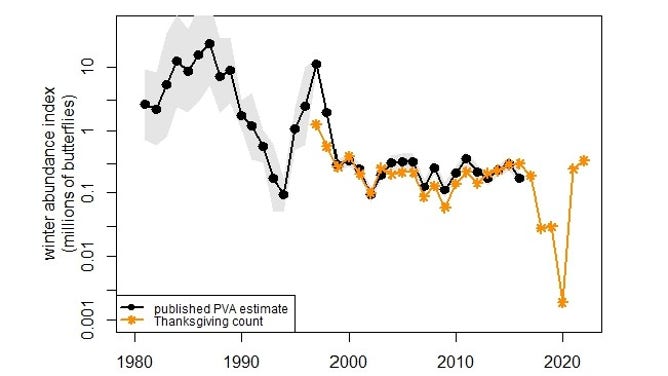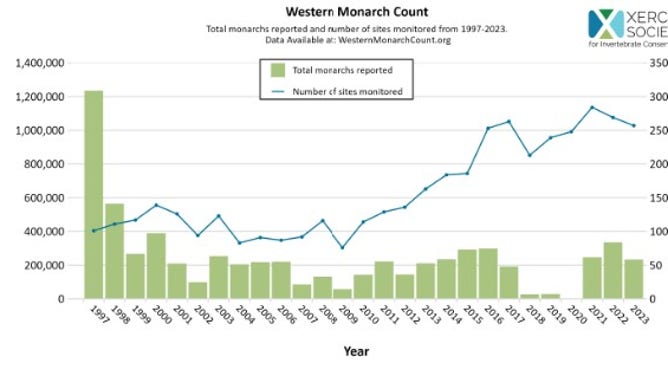Monarch butterfly numbers down after historic winter storms thrashed California population, researchers say
The November western monarch butterfly count across California totaled 30% fewer butterflies than last year and just 5% of the population numbers from the 1980s.
Fast facts about monarch butterflies
Learn more about migratory monarch butterflies -- the iconic orange-and-black insects that signal spring and summer.
Western monarch butterfly populations are far from recovered after winter storms left the population of the delicate insects in tatters. The recent count of the overwintering population across California was 30% lower than last year’s count, according to researchers.
"Last year’s winter storms meant we entered the spring breeding season with fewer butterflies and saw lower numbers this summer, so it is not surprising that the overwintering population is down," said Emma Pelton, a monarch conservation biologist with the Xerces Society. "It’s difficult to predict how conditions during any single year will influence the population, but we do know that western monarch numbers need to be much higher before we consider this a recovery."
Monarchs stop laying eggs for the winter and cluster in protected coastal groves from the northern Baja Peninsula to northern California from October through March. The insects focus on preserving energy for migration. About 76% of the western monarchs overwinter in Central California. One small grove in Pismo Beach hosted more than 16,000 monarchs in November.
RELENTLESS CALIFORNIA ATMOSPHERIC RIVERS DROP 32 TRILLION GALLONS OF WATER OVER 3 WEEKS
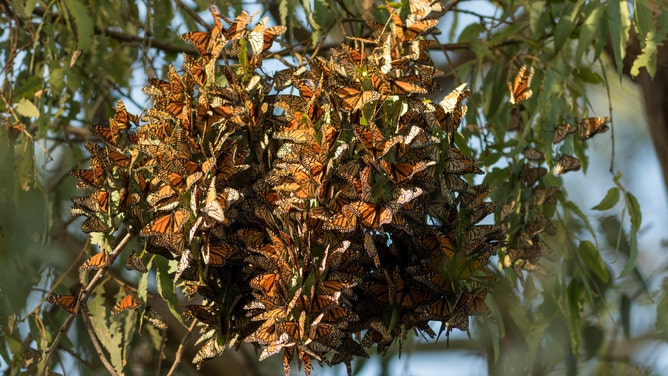
Thousands of monarch butterflies cluster on eucalyptus tree limbs.
(Photo by Yichuan Cao/NurPhoto via Getty Images / Getty Images)
Deadly parade of storms last year
The number of butterflies dropped by more than half from Xerces' November 2022 count to their January 2023 count. The 58% drop was the greatest of the count's 27-year record due to the seemingly relentless parade of atmospheric river-fueled storms. They killed butterflies but also damaged the groves where monarchs cluster for protection from winter storms, rain, strong wind and freezing temperatures. The damage provided less shelter this winter.
"In California, especially last year, we had the atmospheric rivers that were back-to-back, through January," said Isis Howard, Endangered Species Conservation Biologist for the Xerces Society. "We saw a lot of our trees fall in overwintering sites, causing changes to the overwintering groves, allowing more wind, more rain, etc., to enter the groves and disrupt the monarch butterflies that were clustering there for protection."
Over 400 volunteers counted 233,394 butterflies across 256 California sites. Last winter, the November count, which is traditionally the peak overwintering time, totaled more than 330,000.
DRAMATIC IMAGES SHOW DEVASTATION FROM ONSLAUGHT OF ATMOSPHERIC RIVERS SLAMMING CALIFORNIA
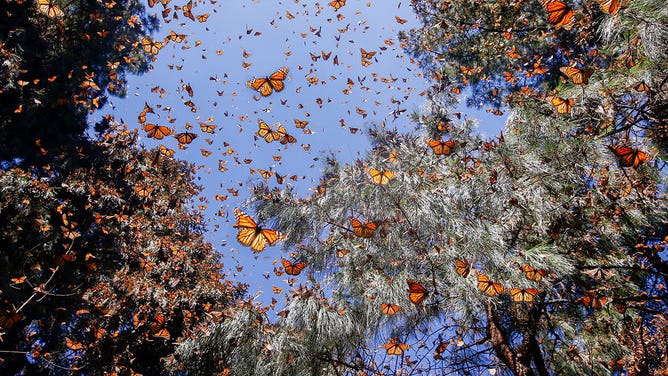
Monarch butterflies are seen in one of their wintering grounds in Angangueo, Michoacan State, Mexico.
(Sylvain CORDIER/Gamma-Rapho / Getty Images)
RIDICULOUS PHOTOS SHOW AFTERMATH OF 12 FEET OF SNOW IN CALIFORNIA'S SIERRA NEVADA
"When populations are low, small changes in factors like temperature, rainfall, predation and availability of milkweed and nectar resources can strongly influence each generation’s survival rates," explained Howard.
Slow improvement since 'bottom fell out' of population
Population numbers are at a mere 5% compared to the low millions counted in the 1980s. Pelton said "the bottom fell out" in 2018, 2019 and 2020 when counters found less than 30,000 each year. Since then, numbers have slowly improved.
"So we have bounced back, but we haven't bounced back fully," said Pelton.
Despite the precipitous decline, the U.S. Fish and Wildlife Service has not listed the insect under the Endangered Species Act.
"In December 2020, after an extensive status assessment of the monarch butterfly, we determined that listing the monarch under the Endangered Species Act is warranted but precluded at this time by higher priority listing actions," stated USFWS. "With this finding, the monarch butterfly becomes a candidate for listing; we will review its status each year until we are able to begin developing a proposal to list the monarch."
MONARCHS LISTED AS ENDANGERED BY INTERNATIONAL UNION FOR CONSERVATIONS OF NATURE'S RED LIST
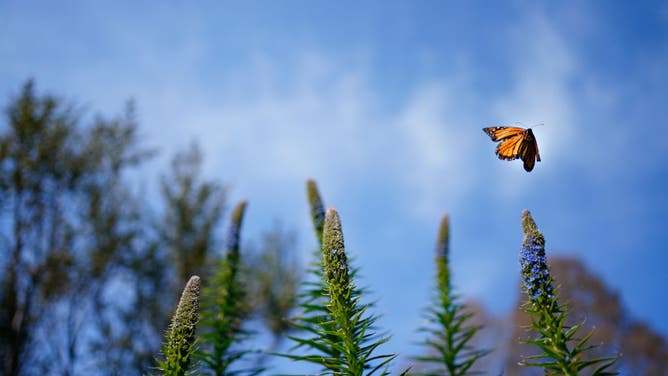
A Western Monarch Butterfly flourishes in gardens which were created to support pollinating insects and birds at The Gardens at Lake Merritt in Oakland, California on Thursday March 18, 2021. (Photo by Melina Mara/The Washington Post via Getty Images)
(Getty Images)
USFWS is court-mandated to reconsider listing the butterfly by the end of the fiscal year, the end of September.
"Unless something had really changed dramatically in the population status in Mexico or California, which it really hasn't, I think by any objective measure, the overwintering numbers in Mexico have been the same or going down, similar to the West that we anticipate that they will list the monarch and that that could come out as soon as this fall," said Pelton.
Howard said the year-to-year fluctuations are common in declining invertebrate populations.
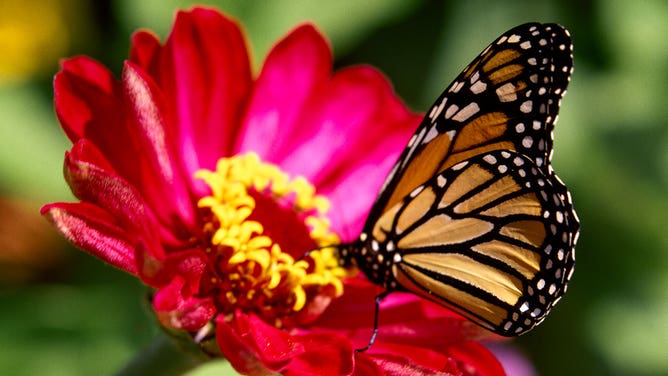
A monarch butterfly feeds on a flower.
(K Vreeland/Classicstock / Getty Images)
Both the eastern and the western monarch numbers are down. USFWS points to the conversion of grasslands to agriculture, urban development, widespread use of herbicides, logging/thinning at overwintering sites in Mexico, unsuitable management of overwintering groves in California, drought, use of insecticides and climate change for the decrease.
Western monarchs stay west of the Rockies, while the population of eastern monarchs stay east of the Rockies. Generation after generation of monarchs fly to the same winter site, often the same tree, year after year.
PESTICIDE-FREE MILKWEED FOR BUTTERFLY GARDENS MAY BE HARD TO FIND AT NURSERIES, NEW STUDY FINDS
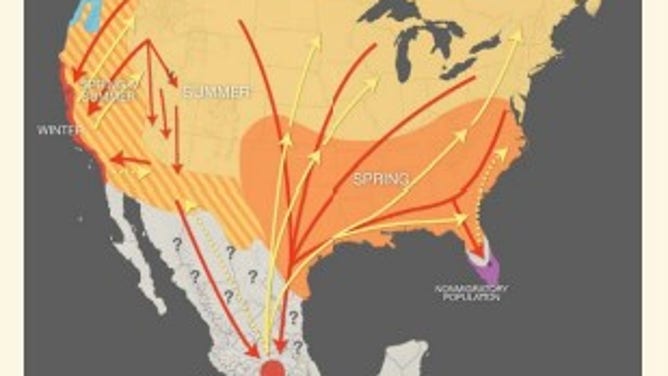
Western monarch butterflies west of the Rocky Mountains migrate to the California coast for winter. Eastern monarchs migrate to Mexico.
(The Xerces Society)
Why count monarchs?
Howard said the monarch counts are essential for the future of all pollinators. The U.S. Department of Agriculture estimates that pollinators are responsible for one out of three bites of food Americans take.
"Monarch butterflies are a flagship species," Howard said. "In other words, they're sort of the poster child for butterfly and pollinator conservation efforts."
"So this is one reason why we emphasize the plight of the monarch, and we put a lot of energy and effort into preserving monarchs," she added. "They also indicate the declines of other at-risk butterflies, bees, moths, beetles, that are happening across North America and beyond. So, the declines in monarchs reflect the declines in other beneficial insects and pollinators."
WHERE IS THE WESTERN BUMBLEBEE? THE SUPER-POLLINATOR DECLINED 57% IN 2 DECADES, SAID STUDY
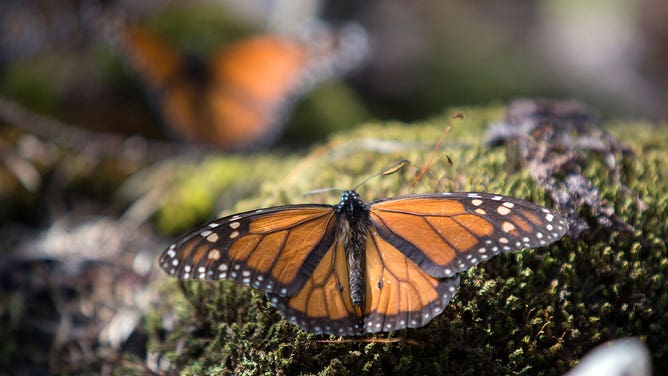
A monarch butterfly rests on a piece of moss at the Sierra Chincua Butterfly Sanctuary near Angangueo in the state of Michoacan, Mexico, on Saturday, Jan. 17, 2015.
(Susana Gonzalez/Bloomberg via Getty Images)
How do volunteers count the flying insects?
Xerces holds virtual and field training every fall for volunteers. Each one painstakingly counts butterflies in a section of a tree and then estimates numbers for the entire tree. FOX Weather spoke to a volunteer previously. Counters head out in the cool mornings when the animals are in torpor or paralyzed by the cold.
Counting the Monarchs
An official Monarch butterfly counter describes the process.
Volunteers are completing the January count, which will enable Xerces to tabulate a final number for the winter of 2023/24.
"The data from the western monarch count informs conservation efforts, and it allows scientists to make informed decisions to protect monarchs and their winter habitat," said Howard.

